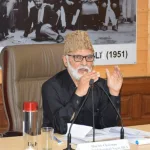As we step into the future, our cities are increasingly finding themselves at the crossroads of development and sustainability, modernity and tradition, aspiration and preservation. Further, the unprecedented population growth has also put an additional strain on the infrastructures and will in turn result in deficiencies including housing, water supply, electricity, sewerage system, health, public transport and education.
The Srinagar city characterized by its traditional architecture and picturesque surroundings is grappling with the pressures of modernization, population growth, and climate change. Over recent years, the unplanned expansion of urban areas, inadequate infrastructure, and poor waste management have significantly affected the natural beauty of the city. The rapid encroachment of construction into ecologically sensitive areas, such as floodplains and wetlands, exacerbates local climate-related risks.
Urban flooding, for instance, is becoming increasingly common due to the lack of proper drainage systems and the destruction of natural water bodies. Moreover, a lack of efficient public transportation systems and unregulated traffic has led to increased congestion and pollution, affecting the quality of life for local residents and tourists alike. The unique architectural heritage is also at risk due to the absence of regulations that safeguard these traditional structures. Addressing these issues requires a reimagining of urban planning in the UT.
There is an urgent need for the incorporation of sustainable and resilient urban planning strategies that balance the needs of development with environmental conservation and cultural preservation. The government and the concerned authorities should frame comprehensive land-use policies that prevent unregulated construction in ecologically sensitive areas. These policies should encourage development in designated zones while preserving green spaces and traditional Kashmiri architecture.
Also, infrastructure development should focus on creating robust public transportation systems, efficient waste management, and drainage systems that can reduce pollution and congestion while increasing the UT’s resilience to climate change. Experts are of the opinion that citizen participation should be at the heart of urban planning.
Local populace has a deep understanding of their environment and a vested interest in its preservation. Their voices must be heard and their insights considered in the planning and decision-making processes. The need of the hour is to overcome the pitfalls of unregulated urbanization and embrace a new paradigm of sustainable and inclusive urban development. The choices we make today will determine the legacy we leave for future generations.
(Author is a research scholar and social activist)








